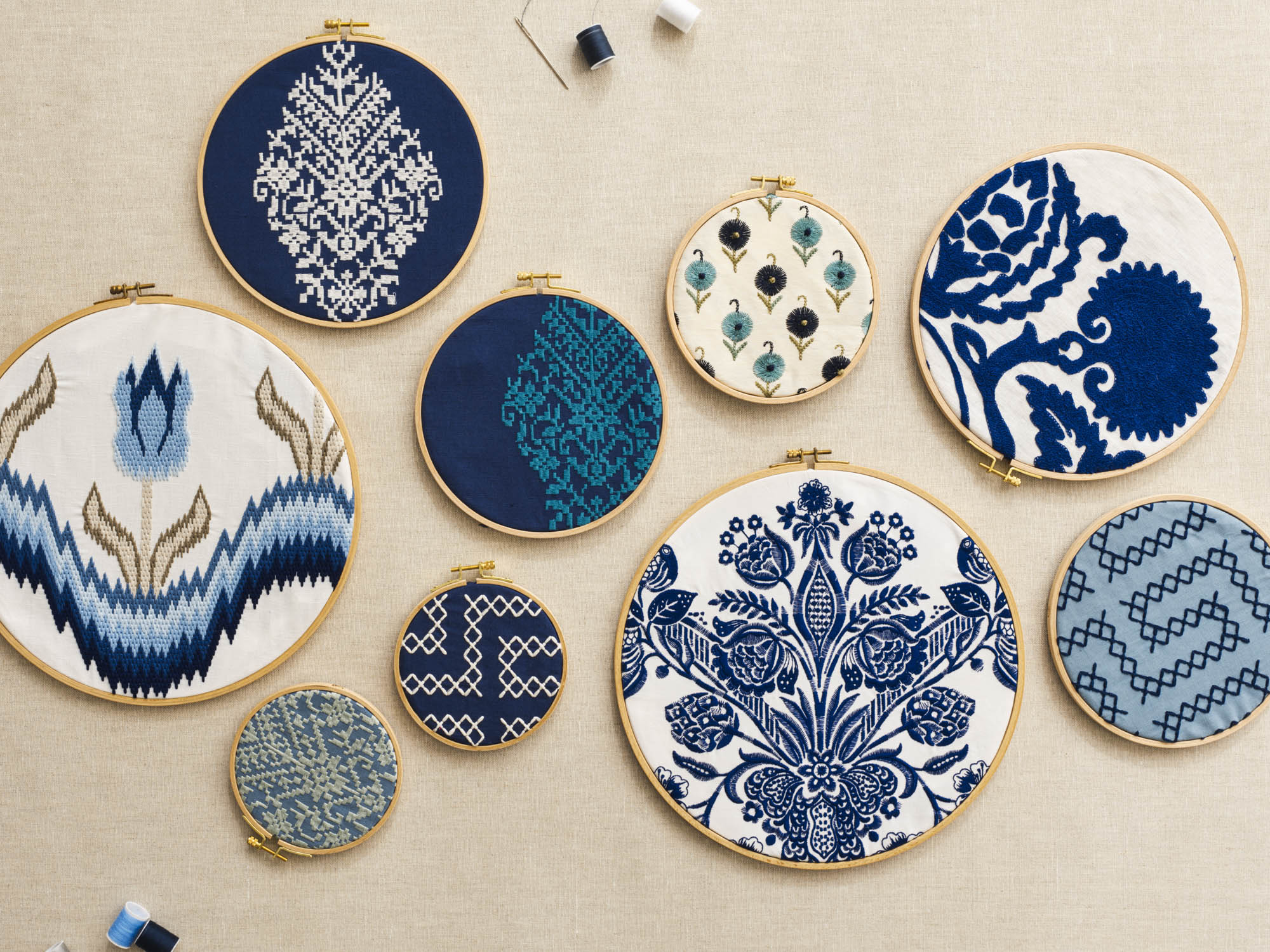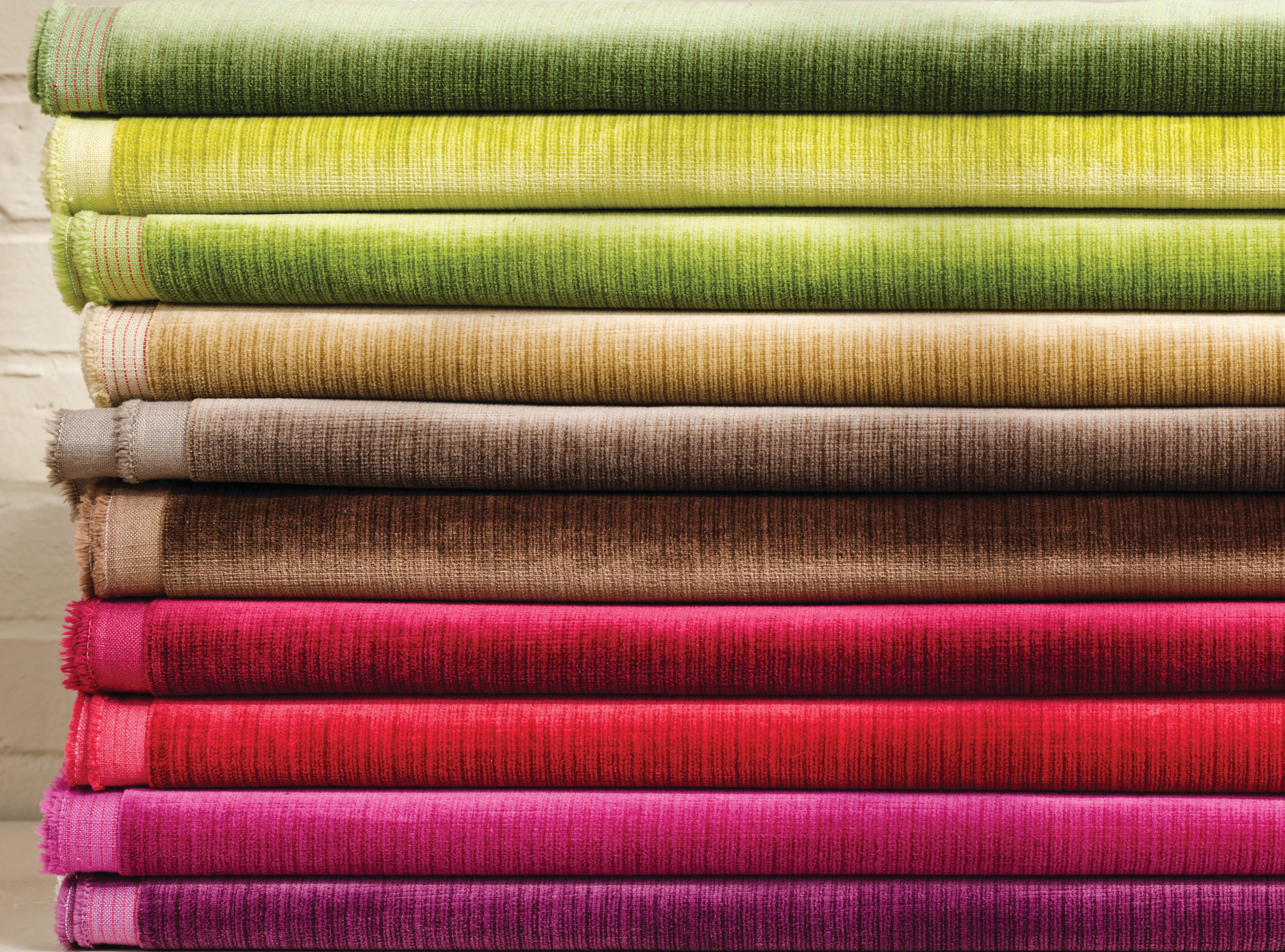From “butt joints” to “dye lots,” the wallpaper trade has a language of its own. Whether you’re ordering wallpaper for an interior design client or yourself, hiring a wallpaper installer, or dipping your own toes into the world of wallpaper installs, understanding wallpaper terminology is essential to a beautifully executed wallpaper installation. Polish up on this wallpaper glossary and you’ll be talking the talk in no time.

Hand Combed Plaster Wallpaper in Yves Blue by David Kaihoi for Schumacher.
Strippable
A strippable material can be removed by simply prying up a corner and pulling off the whole strip. Strippability means that the base material used for the wallcovering is sufficiently strong to break away from the adhesive without shredding.
Washable
The term washable means that a wallcovering may be washed off with a mild soap and water without damage to the pattern or base stock. It does not assure that soil, grease or stains are removable. Washability varies with different lines. If soil, grease, and stain resistance are necessary, it is best to have paper products resistance coated for maximum durability.
Prepasted
A prepasted wallcovering does not require an application of paste before hanging. This kind of wallcovering has been treated with a dry adhesive during manufacturing. Simply running it through water activates the paste. If you still prefer to apply the paste to a prepared paper, the paste should be thinned to about ½ its normal consistency for hanging wallcoverings that are not prepasted. Follow instructions carefully.
Companion Fabrics
Many Schumacher fabrics have been created to simulate wallcovering patterns
(and vice versa)—look for the label “also available as wallcoverings/fabrics” on our product detail pages. Even though patterns are similar, the difference in materials, dyes and printing processes may cause the color scale to vary. Do not expect an exact match. Fabrics are sold by the yard and may be purchased without coordinated wallcoverings.
Pretrimmed
Most machine-printed wallcoverings are pretrimmed, but the majority of handprints and hand-made textures are untrimmed. Careful trimming with a very sharp blade supported by a metal straightedge assures a good butting edge.
Dye Lots
Each printing of a pattern may vary in color and intensity in various degrees. This is why each printing is usually designated with a different dye lot number and this number is shown on the bolt of wallcovering, as well as under the “availability” section of our product detail pages.
When ordering, order sufficient material. It is not always possible to obtain additional rollage in the same dye lot. If it is necessary to order additional, then always specify the desired dye lot as well as the pattern number.
If different dye lots are used, it is advisable to use them on different walls, in nooks or adjoining areas and to visually “shade” them before hanging. In fact, always check the material before hanging and cutting for correct visual color as well as for correct pattern and dye lot number.
Do not expect a paper with a companion fabric to match exactly. Since runs within the paper vary, obviously, dye lots and printing of fabrics vary also. Even the pigments and the processes used in the manufacturing differ. Again, visual checking before cutting is the best method for assuring satisfaction.
Pattern Repeat
Pattern repeat is the distance between one point to the next repeated same point. This may vary from no repeat or match (as on a texture) to repeats as large as 48″. Therefore, for an exceptionally large repeat, you should be sure to order additional paper.
Straight Match and Drop Match
When hanging a patterned wallcovering, the left side of a strip will match or continue the design with the right side of the previous strip. If this match is directly across on a horizontal line, then it would be called a straight match. If the second strip has to be lowered in order to continue the design, then this is called a drop match. A drop match does not necessarily mean that more wallcovering must be ordered, but must be taken into consideration when cutting the strips.
Butt Joints
Wallcoverings should not be overlapped at the seams. If the wallcovering is not pretrimmed, it should be carefully cut by hand and each strip hung so that the edges are just touching together; This is called a butt joint or butt seam. If properly done, this method does not leave a ridge, and the seams are hardly noticeable.
Lining Paper
An inexpensive blank paper stock that is recommended for use under foils or other fine-quality papers. It absorbs excess moisture and makes a smoother wall surface. A canvas liner is also available for “bad” walls.
Murals
Murals are large-scale, non-repeat, hand screened patterns done on a series of panels. They may be scenic, floral or architectural in nature. Murals are usually sold in sets varying from two to six or more panels per set. Each panel is normally 28″ in width and printed on strips 10-12 feet in length. The height of the designs vary greatly, but most fall somewhere between 4 to 8 feet. The average 4 panel mural will cover an area approximately 9’4” in width and the panels will extend from floor to ceiling without having to be placed.
There are basically three types of murals:
- The continuous mural is one that can be extended by adding another set or additional panels.
- The non-continuous mural is one that fades off on the extreme edges of the set. Plain grounds are available for this extension.
- The single-panel mural is made up of panels complete by themselves which may be spotted between panels of plain ground to extend the mural or to locate the design only in strategic locations.
If additional background paper or sets are to be used, then they should be used on different walls if possible. An exact color match can not be guaranteed between sets and the additional background rollage.
Vinyls
Vinyl refers to a whole family of chemical compounds. It is a term loosely used to mean anything from a light coating to a thick vinyl chloride-bonded surface. Generally speaking, there are three basic categories:
- Plastic or vinyl coated.
- Vinyl latex impregnated.
- Solid vinyl chloride film.
Plastic-coated papers are ordinary papers that have a final coating of plastic latex applied. The thickness and quality of this coating will vary considerably. The more fragile the nature of the film, the less resistant. Therefore, these coated papers are usually termed washable and should be considered less durable than other types.
Vinyl latex-impregnated papers are papers that have latex added to the decorative inks as well as having a latex final coating. Again, the amount and quality of the latex used will vary with the manufacturer. As a whole, these latex-impregnated papers are more stain-resistant and can be considered scrubbable (though not recommended for heavy traffic areas or harsh soiling conditions).
A true vinyl wallcovering is one in which vinyl chloride resin is used as a binder and the amount and thickness of the resin bonded surface determines whether it is called light, medium or heavy. The thickness determines the resistance to abrasion and scuffability even though a lightweight vinyl would be as stain resistant as the heaviest weight.
Laminating
A two-step process in which a vinyl film is made, then fused to the substrate (backing) by means of heat and pressure. Most vinyl handprints are processed in this manner.
Spread-coating
A process in which several coatings of vinyl chloride are applied in a liquid state to the substrate. This is done by means of an air blade, knife or a reverse roll technique.
Calendering
A process in which the vinyl chloride is mixed to the consistency of dough and put through a series of hot rollers which knead it out to the desired thickness and bond it simultaneously to the substrate. This makes a homogeneous piece of material and used predominately for large-quality production runs.
There are many different materials used as a substrate. Vinyls may be paper backed, on dacron or avisco rayon substrate, or on canvas backing made of scrim, or drill fabric. The backing does not affect the stain resistance of the vinyl but will affect the hanging, removing, weight, and resistance to abrasion.
In all three manufacturing processes, after the vinyl wall-covering is embossed and printed with vinyl inks, a clear or pigmented protective vinyl coating is applied.



